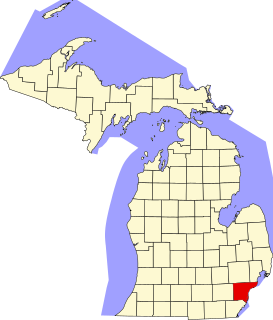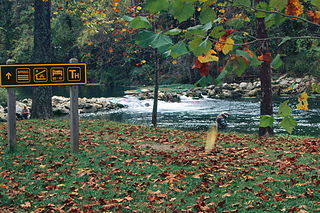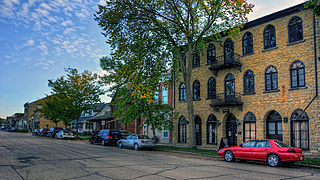
Springdale is the fourth-largest city in Arkansas, United States. It is located in both Washington and Benton counties in Northwest Arkansas. Located on the Springfield Plateau deep in the Ozark Mountains, Springdale has long been an important industrial city for the region. In addition to several trucking companies, the city is home to the world headquarters of Tyson Foods, the world's largest meat producing company. Originally named Shiloh, the city changed its name to Springdale when applying for a post office in 1872. The four-county Northwest Arkansas Metropolitan Statistical Area is ranked 109th in terms of population in the United States with 463,204 in 2010 according to the United States Census Bureau. The city had a population of 69,797 at the 2010 Census.

Fayetteville is the second-largest city in Arkansas, the county seat of Washington County, and the biggest city in Northwest Arkansas. The city is on the outskirts of the Boston Mountains, deep within the Ozarks. Known as Washington until 1829, the city was named after Fayetteville, Tennessee, from which many of the settlers had come. It was incorporated on November 3, 1836, and was rechartered in 1867. The three-county Northwest Arkansas Metropolitan Statistical Area is ranked 102nd in terms of population in the United States with 560,709 in 2021 according to the United States Census Bureau. The city had a population of 95,230 in 2021.

Tyson Foods, Inc. is an American multinational corporation, based in Springdale, Arkansas, that operates in the food industry. The company is the world's second-largest processor and marketer of chicken, beef, and pork after JBS S.A. It annually exports the largest percentage of beef out of the United States. Together with its subsidiaries, it operates major food brands, including Jimmy Dean, Hillshire Farm, Ball Park, Wright Brand, Aidells, and State Fair. Tyson Foods ranked No. 79 in the 2020 Fortune 500 list of the largest United States corporations by total revenue.

This is a list of the National Register of Historic Places listings in Wayne County, Michigan.

Bennett Spring State Park is a public recreation area located in Bennett Springs, Missouri, twelve miles (19 km) west of Lebanon on Highway 64 in Dallas and Laclede counties. It is centered on the spring that flows into the Niangua River and gives the park its name. The spring averages 100 million gallons of daily flow. The park offers fly fishing, camping, canoeing, hiking, and other activities.

Donald John "Don" Tyson was an American businessman who was the President and CEO of Tyson Foods during its rise to the top of the food business.

The Northwest Arkansas Naturals are a Minor League Baseball team based in Springdale, Arkansas. The team is a member of the Texas League, and serves as the Double-A affiliate of the Kansas City Royals. The Naturals play at Arvest Ballpark, which opened in 2008 and is located at the intersection of Gene George Boulevard and Watkins Avenue. The team relocated from Wichita, Kansas, in 2008, where they were known as the Wichita Wranglers.

Reedville is an unincorporated town in Northumberland County in the Northern Neck region of the U.S. state of Virginia. It is located at the eastern terminus of U.S. Route 360 east of Heathsville, at the head of Cockrell's Creek on the western shore of the Chesapeake Bay.

A total of ten special routes of U.S. Route 71 exist.

The Lake Fish Hatchery Historic District comprises nine buildings built between 1930 and 1932 by the U.S. Fish and Wildlife Service in the National Park Service Rustic style. The buildings exhibit a consistency of style and construction, with exposed gable trusses and oversized paired logs at the corners, all with brown paint. The district is located on the shore of Yellowstone lake near the Lake Hotel The hatchery was established to provide Yellowstone cutthroat trout eggs for state and federal hatcheries outside Yellowstone.
John W. Tyson was an American businessman, the founder of American multinational corporation Tyson Foods and, from 1935 until his death in 1967, its chief executive officer.

The historical buildings and structures of Zion National Park represent a variety of buildings, interpretive structures, signs and infrastructure associated with the National Park Service's operations in Zion National Park, Utah. Structures vary in size and scale from the Zion Lodge to road culverts and curbs, nearly all of which were designed using native materials and regional construction techniques in an adapted version of the National Park Service Rustic style. A number of the larger structures were designed by Gilbert Stanley Underwood, while many of the smaller structures were designed or coordinated with the National Park Service Branch of Plans and Designs. The bulk of the historic structures date to the 1920s and 1930s. Most of the structures of the 1930s were built using Civilian Conservation Corps labor.

Albert Oscar Clark (1858–1935), commonly known as A.O. Clark, was an American architect who worked in Arkansas in the early 1900s.

The Hopkins Feed and Seed Store is a historic commercial building at 301 East 3rd Street in downtown Texarkana, Arkansas. It is a single-story brick building roughly rectangular, with a beveled entrance at the corner of 3rd and South Wood Streets. It was built c. 1922 by Roy Hopkins, who operated a feed store and chicken hatchery on the premises. The building, still used as a feed store, is the only one of the period to survive on the block.

The broiler industry is the process by which broiler chickens are reared and prepared for meat consumption. Worldwide, in 2005 production was 71,851,000 tonnes. From 1985 to 2005, the broiler industry grew by 158%.

Shiloh Historic District is a historic area of downtown Springdale, Arkansas listed on the National Register of Historic Places. The district encompasses eighteen significant buildings within its 32 acres (13 ha), with eight having historic or architectural significance and twelve relating to the early commercial and industrial development of Springdale. Also included within the area are several roads of historic significance to the city. The district covers an area straddling Spring Brook, around which the community developed beginning in the 1830s, and is roughly centered on the 1870 Shiloh Church building, which is the community's oldest surviving building.

The Price Produce and Service Station is a collection of three related commercial buildings at 413, 415, and 417 East Emma Avenue in Springdale, Arkansas. It includes one building that hosted an automotive filling station and produce shop, a second that traditionally housed a barbershop, and a third structure, originally open but now enclosed and housing a residence, that was used as an automobile service area. The buildings were all built in 1934, and are united by common Art Deco styling, most prominently lancet-topped pilasters that rise above the height of their roofs. The complex is regarded as a fine local example of vernacular Art Deco, and as a surviving element of the automotive culture of the 1930s.

The Front Street Historic District is a nationally recognized historic district located in Guttenberg, Iowa, United States. It was listed on the National Register of Historic Places in 1984, and in 2004 its boundaries increased to include buildings that did not front onto River Park Drive. At the time of its nomination the district consisted of 75 resources, including 57 contributing buildings, one contributing site, and 17 noncontributing buildings. The boundary increase added 19 resources, including 15 contributing buildings, one contributing site, and 3 noncontributing buildings. The 4½ block segment of South River Park Drive, originally called Front Street, that makes up the district is the commercial center of Guttenberg. The buildings line the west side of the street facing a park, a contributing site, and the Mississippi River across the street. The National Fish Hatchery and Aquarium complex (1939-1940), whose buildings contribute to the historic nature of the district, is also located on the east side of the street.
Mountaire Farms is the fourth-largest producer of chicken in the United States, with headquarters in Millsboro, Delaware. The company operates internationally, serving the United States and foreign markets as far away as Asia. Mountaire Farms has facilities in the states of Arkansas, Delaware, Maryland, North Carolina, and Virginia. The company has about 7,000 employees and plays a major part in the economy of Delaware.

The Meat Racket: The Secret Takeover of America's Food Business is a 2014 book by Christopher Leonard about the meat processing industry in the United States that focuses on Tyson Foods as the market leader. Widely reviewed on publication, the book gained additional attention during the COVID-19 pandemic in 2020.


















